HADZABE – THE LAST HUNTER GATHERERS IN EAST AFRICA
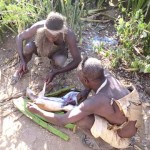
Watching a bushman skin a dik dik is an experience not to be forgotten (and probably one that falls into the ‘once is enough’ category). Within minutes the animal, killed with a skilfully aimed arrow just an hour earlier, is stripped and laid out on the roof of the grass hut to dry in the hot morning sun.
The hunter is one of a tiny population of Hadzabe bushmen; the very last hunter gatherer tribe left in east Africa. They live (almost) as they have done for centuries; hunting the local wildlife and supplementing their diet with berries and roots. They shelter in rough huts made from the surrounding plants, and when the rains come they move to the nearby caves or cut into the hollow trunk of a giant Baobab tree to keep dry.
Originally these people lived in the Ngorongoro region of Tanzania but around 300 years ago the Masai arrived, having moved south from Sudan and through Kenya. They fought with the Hadzabe and pushed them off the fertile land of the Ngorongoro crater into the inhospitable terrain of Lake Eyasi.

Lake Eyasi lies in the Eyasi-Wembere branch of the Great Rift Valley at the base of the Serengeti Plateau, just south of the Serengeti National Park. It’s a migration stop for flamingos – which can be seen in their thousands sifting through the salty water. The flamingos are a spectacular sight – but other wildlife is lacking, making this an area little visited by tourists.
This lack of visitors is both a blessing and a curse; like so much related to global tourism, it has two sides.
On the one hand a visit here is said to help us understand the lives of these disappearing peoples, and the fees the tourist pays to enter the Lake Eyasi Conservation area helps to pay to protect the land. And this brings you to the other side of the tourism coin…
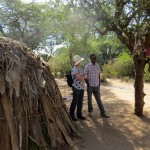
By bringing tourists here money enters the equation. By keeping the Hadzabe as they are (primitive hunter gatherers) tourists come to the region to gawp awkwardly (in the belief that they are helping the people and learning about them) when in fact that money can act as an incentive to keep the people as a sort of ‘zoo attraction’. Empowering them, or giving them an opportunity to change their lives would mean the end of the tourist dollar.
However what we see today is not really authentic anyway – the damage has already been done. Originally the Hadzabe were nomadic – but not anymore. After all you can’t have tourists turn up to see bushmen who have upped sticks and moved on.
But that’s not all. Part of the ‘tourist experience’ is the opportunity to go on a hunt with them. Normally hunting would be a small part of their diet and activities – the bulk of their food coming from gathering. Wildlife is scarce here as a result of human encroachment, over population, and over hunting. In the past the bushman may kill a large gazelle and not need to hunt again for days. Today there are no large animals to kill – just a few tiny dik-diks. Even these are disappearing fast as the hunters put on a ‘show’ for the tourists.
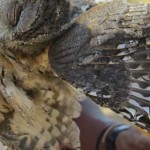
When we arrived three dik-diks had already been killed that morning – far more than is sustainable. We were then taken on a hunt which resulted in the death of three small birds (a pygmy owl and two doves) – there was no need to kill these birds. They are so small they are hardly worth eating and with three dik-diks already cooking they were for show – not the pot.
This form of hunting is not subsistence – it is show business. And if the show continues the wildlife will soon disappear completely.
And what will happen to the Hadzabe then? We say we are helping to ‘preserve these people and their ancient culture’ but at this rate we’ll soon be sending them food parcels to prevent them from starving. Will that be a successful preservation of a people and their culture?
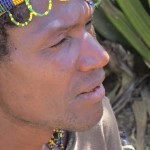
Visiting the Hadzabe is certainly interesting – but it’s also uncomfortable. It’s ‘poverty tourism’; let’s go and look at the poor people. I asked if they minded us all traipsing through their home and was told they were happy about it because of the money it brought. That’s a convenient answer and helps us to feel good rather than guilty – after all no one wants to go on holiday to feel bad. But I am not convinced it’s the full truth. Or a good thing. And if they really were living as their ancestors did – then money isn’t something they’d need.
Let’s consider for a moment other places where the indigenous people have been ‘given’ land in order to ‘protect their heritage and way of life’ … think Native American reservations, aboriginals in Australia, the Inuit peoples… What do they all have in common in the 21st century? Problems with drugs, drinks and unemployment.
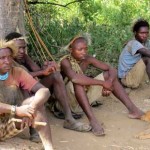
The brightest and most dynamic have left the reservations to make something of their lives and the rest have settled back, opting to become zoo exhibits in exchange for a few easy dollars. No wonder they end up feeling demotivated, disempowered and depressed.
So, should you visit them? Is your interest and your money empowering or disempowering? The answer is probably that it’s a bit of both. Personally I am not a fan of poverty tourism or animals being killed needlessly – and as Tanzania has so many other things to offer (which pose less of an ethical dilemma) I would prefer to stay away.
FACT BOX
Travelling with an ethical safari company can help ensure your money is having a positive impact on local people. Check out Tropical Trails which has an ethos of empowerment and giving back to the community.

About the Author:
Chantal Cooke is an award winning journalist and broadcaster with a passion for the planet. In 2002 she co-founded the award winning radio station PASSION for the PLANET and in 2009 Chantal was awarded London Leader in Sustainability status. Chantal also runs a successful communications agency – Panpathic Communications.

